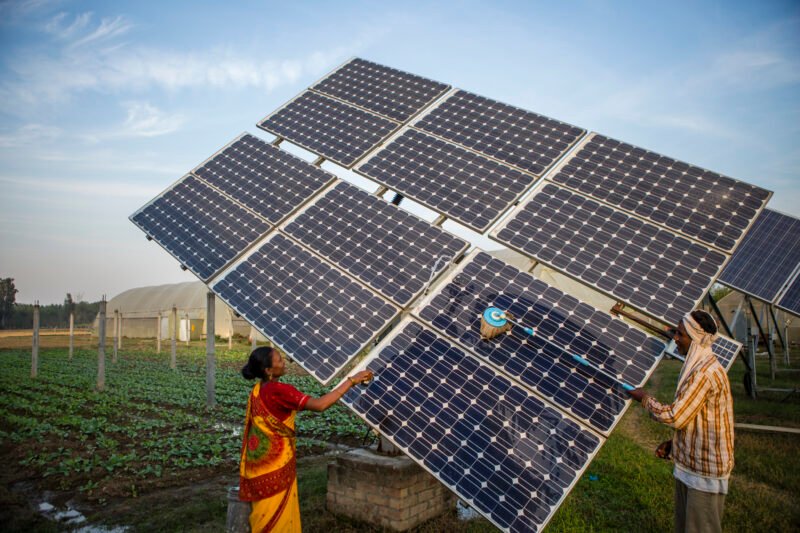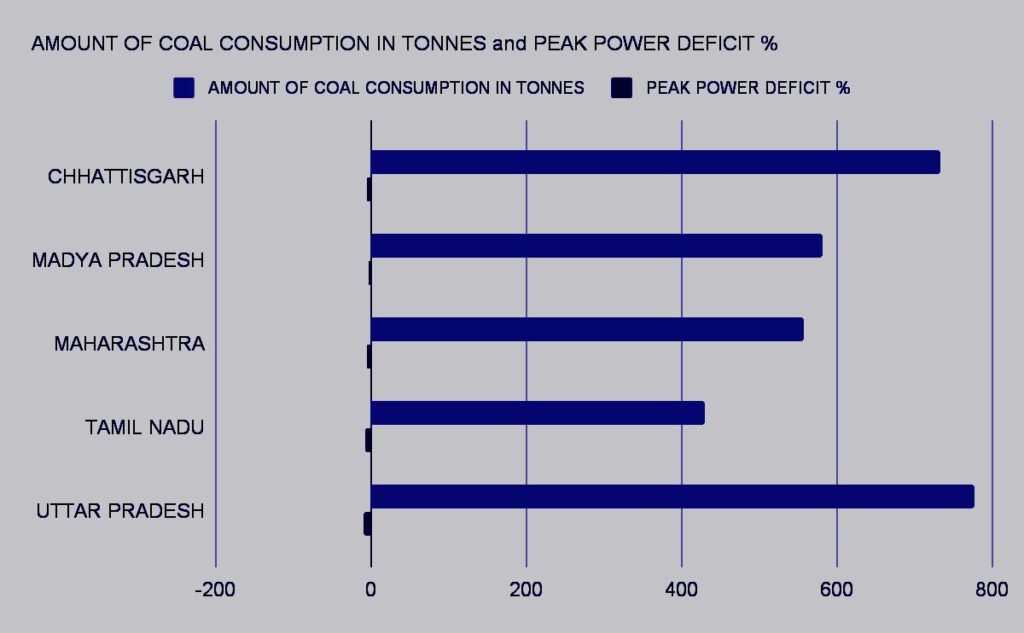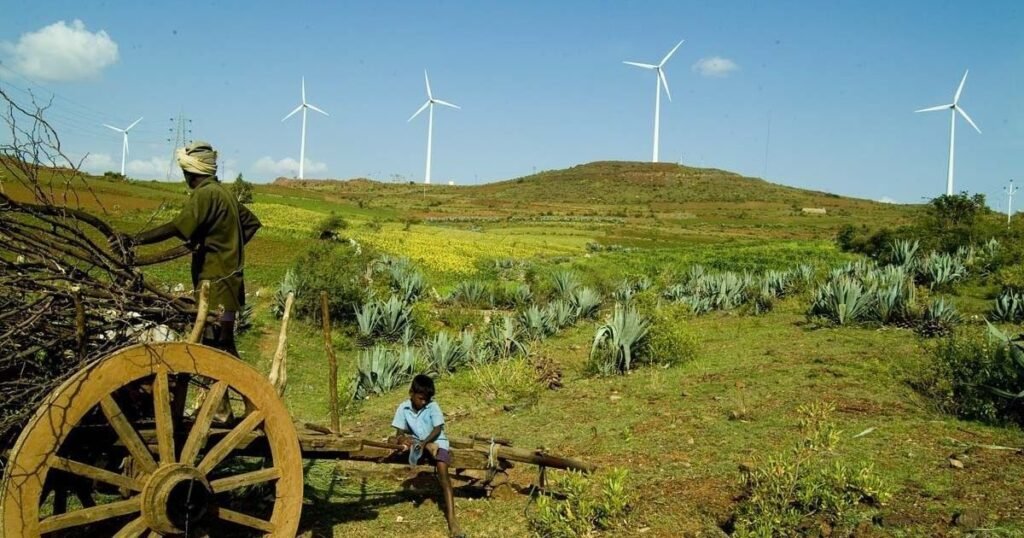The significance of renewable energy for the Indian economy

An analysis of the impact of the renewable energy transition on economic development
In India, renewable energy is a critical component in solving climate change and energy security concerns, including its commitments to COP 21. India is dependent on coal, and its economy is strongly susceptible to it. The pollution and environmental effects of coal have been clearly established, and now is the time for a comprehensive reconsideration. India’s air quality should not be sacrificed in the name of development(Indian cities rank among the most polluted in the world (IQAir, 2021). India has the potential to create a renewable energy boom, empowering it to carry out the world’s most significant energy transition. India’s choices, as a developing economy with a significant population, have the potential to make or break the world’s battle over climate change.
Electricity and Coal Consumption.
India has made incredible strides in current energy projects, but there are still numerous obstacles to overcome. In current days, India has connected hundreds of thousands of people to electricity, encouraged the widespread use of energy-efficient driving in most homes, and pushed a tremendous increase in renewable energy sources, led by solar energy. Based on the data from IEA, there is still a dearth of electricity access for many customers; 660 million people continue to rely on biomass resources, primarily firewood, as a fuel for cooking; and the quality of air has placed urban areas as one of the most contaminated in the globe (IEA, 2021). India produces roughly 729 million tonnes of coal at present. Domestic output, on the other hand, is unable to supply the country’s demand for coal. Last year, India bought 247 million tonnes of coal and spent Rs 1.58 lakh crore on foreign exchange. The need for the import of coking coal is understood, but the power sector and many manufacturing areas use non-coking coal. The domestic demand still outstrips the domestic supply.

These states were selected for their higher power deficits in the period and their high coal consumption for electricity. The electricity fluctuations in these states show an inconsistent trend that matches with the IEA’s concerns about the reliability of electricity supply where coal plays its role. Uttar Pradesh and Maharashtra are two of the most populous states, and their peak deficits show the struggle to cope with the increasing demand for energy.
The Need for a Transformation
As a tropical country, India’s involvement in the opening gambit of the international solar alliance is a well-thought-out move and a remarkable achievement for developing the renewable energy trade spectrum. In 2019, nearly all families received a supply of electricity, bringing the total number of people with electricity to over 900 million in less than a couple of decades. Energy per capita consumption is far below the international average. Another concern is the significant disparities in energy consumption and customer satisfaction around the country. India’s customers are worried about the cost and consistency of electricity availability. This scenario is also essential for the country’s public reputation. The primary rationale for this is that people are becoming more responsive to climate challenges. International bodies are wary of investing in areas with higher pollution rates. The economic dimension of renewable energy comes into relevance here.
Renewed Energy Generation
Renewable energy production in India has risen in its potential and generational capacity after 2011. This data shows the swift improvement in Indian states in renewable energy production. Those states which installed the highest number of RE projects in the period between 2016 and 2020 are taken here for consideration.
RENEWABLE ENERGY GENERATION IN 2016
| TYPES OF RENEWABLES | ANDHRA PRADESH | TELANGANA | KARNATAKA | GUJARAT | RAJASTHAN |
| BIOMASS | 699.28 | 496.69 | 3591.92 | 23.28 | 245.49 |
| SOLAR | 282.67 | 418.53 | 187.69 | 1497.6 | 1775.99 |
| WIND | 2013.04 | 0 | 4797.95 | 6514.1 | 4667.06 |
| WASTE | 8.52 | 79.8 | 0 | 0 | 0 |
| SMALL HYDRO | 103.1 | 48.69 | 1483.48 | 36.27 | 5.06 |
RENEWABLE ENERGY GENERATION IN 2020
| TYPES OF RENEWABLES | ANDHRA PRADESH | TELANGANA | KARNATAKA | GUJARAT | RAJASTHAN |
| BIOMASS | 205.96 | 226.53 | 2376.65 | 122.97 | 389.94 |
| SOLAR | 5855.11 | 6263.92 | 11221.2 | 3631.86 | 7776.56 |
| WIND | 7626.63 | 238.25 | 10148.66 | 13748.53 | 6155.8 |
| RENEWABLES | 7.31 | 19.25 | 0 | 18.77 | 0 |
| SMALL HYDRO | 298.19 | 46.29 | 1901.91 | 194.8 | 9.75 |
These tables provide a relative idea of the significant focus given to solar and wind energy production in the country. Biomass energy generation has remained constant or decreased, whereas solar and wind energy production have increased. All these states have challenges related to demand-supply gaps. Even though Andhra Pradesh is on the right path to achieving its renewable energy obligations, it does face challenges like grid integration and limited balancing reserves. The current installed capacity of RE is 25.0% (6,634 MW) in Gujarat and impressive RPOs targets are managed, but there is a potential to improve these figures and reduce its coal shortages. Karnataka has impressively met its RPO targets but faces challenges in grid integration and gas reserves. In Rajasthan, DISCOMs achieved impressive RPO targets in 2017 but faced limitations in human research and resources in state agencies, which is significant in accommodating the rural sector. The power sector of Telangana is a prime reason behind its impressive development and it is on the right path to achieve its RPO obligations.

Job Generation
The renewable industry of India witnessed $42 billion of investment since 2014 and around $7 billion of foreign direct investment (FDI) between April 2000 and June 2018 (world economic forum, 2020). India’s rankings in the World Bank’s ease of doing business and WEF’s global competitiveness index are impressive and attract more investments. Some prospective international investors in India’s renewable energy industry are GIC Holdings(Singapore), Abu Dhabi Investment Authority, CPPIB and CPDQ from Canada, ORIX (Japan), Sembcorp and APG (Holland).
Here, the updated NRDC, CEEW, and SCGJ reports are cited to propose the possibility of job generation through renewable energy incentives. The significance given to wind and solar energy production is analyzed in this paper. This report suggests an investment in 38 GW of solar and 101 GW of new wind capacity projects to generate 3.4 million jobs by 2030. These jobs are flexible enough to accommodate both permanent and temporary opportunities. Here, China and Germany are examples of producing green jobs from clean energy projects. In the fiscal year 2021, the solar and wind energy sectors employ 111,400 people, with 77% coming from solar and 23% from wind. The pandemic period saw 48% less job production, but the recovering economy is powering new projects that are highly promising. The “Suryamitra training program” is one such example, having trained 78,000 new labor pool members through certificate courses.
Newer possibilities
There are often co-benefits from the use of RE, such as a reduction in air pollution, local employment opportunities, fewer severe accidents compared to some other forms of energy supply, and improved energy access and security. Renewable sources of energy can provide electricity, and many can also provide thermal and mechanical energy, along with manufacturing fuels, allowing them to meet various energy requirements (IPCC, 2022).
- These sources can be structured both in a larger centralized project and in a decentralized fashion too. India is advantageous here Because RE is based on natural power sources, certain RE technologies should be positioned at or close to the energy resource, accumulating energy from scattered energy currents to begin power generation. The geographical certainty of our country and its abundance of natural resources like wind and water dictate this advantage. Local RE facilitations to fulfill regional energy needs have grown in popularity and now encompass a variety of contemporary and sophisticated conventional biomass choices, modest hydropower(mentioned in the above table), and wind energy, consequently increasing and enhancing energy access.
- Considering India’s growing population, energy consumption has continually increased. The role of energy, both at micro and macro levels, is significant for India. As the article has demonstrated, the use of energy is equally important for both levels to attain economic development, which is proportional in both the urban and rural wings of the country. Renewable energy is advocable in this realm as it can be facilitated both as a big project and a decentralized wing. Large solar parks, mini-and micro-grid systems, and rooftop solar panels are the live models for this, which can deliver more labor-intensive models.
- Indian startups are another part of this story where artificial intelligence is being utilized in the sector. Some of them are ZTRIC, QUEnext, and Thingscloud. More policies should be drafted to support these ventures. Government policies can be drafted to ease land acquisitions while relieving utility charges and tariffs (Balaganur, 2019).
- In many renewable energy models, India has technological disadvantages in cases like solar energy storage, scarcity of materials, and electronic waste disposal. Investing in more research projects like establishing more higher studies departments, investing in government clean energy fellowships, recycling PV materials with advanced waste disposal mechanisms, and stressing domestic manufacturing will aid in tackling these limitations to some extent.
- Solar irrigation is another prospect that our policymakers can implement in the rural agricultural sector. Here, renewable energy could be utilized in irrigation, flood management, transportation, and availability of water for dams and regulated waterways to be used for different functions (IPCC, 2022). This is also devoid of the need for large population displacement and threats from public outrages. Increased investments and trade relations will have an impact on local employment (though the net effect is uncertain, according to the IPCC 2020 report).
- The PM KUSUM scheme is such an effort that brings highly effective changes in the farming sector. Rural skill development projects can be applied to improve social awareness about the need for these incentives while also providing employment in these areas.
- Air pollution has a dynamic contributor, which is the automobile and transport industry. A policy approach towards this can be developed through encouraging electric public vehicles with electricity from renewable sources.
- There have been reports of some environmental and wildlife impacts of renewable energy infrastructure. More research should be promoted to study and tackle this.

Specialized policies and institutional mechanisms must be in place to support these goals and reach the target of 500 GW of non-fossil fuel electricity generation capacity. At the same time, renewable energy sources should be implemented on a large scale so they can protect the economies from fossil fuel breakdowns. At the same time, they will help to adhere to the Paris climate change targets.
References
Government of India Ministry of Coal. (2020, December 31). Year End Review 2020- Ministry of Coal. PIB., from https://pib.gov.in/Pressreleaseshare.aspx?PRID=1685058
Balaganur, S. (2019, November 26). How These 5 Startups Are Contributing To India’s Clean Energy Goal 2022. Analytics India Magazine. Retrieved February 26, 2022, from https://analyticsindiamag.com/5-startups-contributing-to-indias-clean-energy-goal/
IEA. (2021, february). India Energy Outlook 2021 – Analysis – IEA. International Energy Agency. from https://www.iea.org/reports/india-energy-outlook-2021
IPCC. (2022, February 17). AR5 Climate Change 2014: Mitigation of Climate Change — IPCC. IPCC. from https://www.ipcc.ch/report/ar5/wg3/
IQAir. (2021). World’s Most Polluted Cities in 2020 – PM2.5 Ranking | AirVisual. IQAir. from https://www.iqair.com/in-en/world-most-polluted-cities
PRS legislative research. (2019, September 20). Analytical Reports. Analytical Reports. from https://prsindia.org/policy/analytical-reports/overview-power-sector
Soni, S., & jyothi prakash, V. (2021, July 20). India should use renewable energy to meet its economic growth targets. Down To Earth. https://www.downtoearth.org.in/blog/energy/india-should-use-renewable-energy-to-meet-its-economic-growth-targets-78111
TERI. (2020, April 30). The Responsible Energy Initiative. TERI. from https://www.teriin.org/project/responsible-energy-initiative#responsible-energy
world economic forum. (2020, January 14). India is the newest hotspot for renewable energy investors. The World Economic Forum. from https://www.weforum.org/agenda/2020/01/india-new-hotspot-renewable-energy-investors/



















